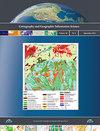Effectiveness of animated choropleth and proportional symbol cartograms for epidemiological dashboards
IF 2.4
3区 地球科学
Q1 GEOGRAPHY
Cartography and Geographic Information Science
Pub Date : 2023-11-02
DOI:10.1080/15230406.2023.2264755
引用次数: 0
Abstract
ABSTRACTEpidemiological maps on COVID-19 dashboards were critical to disseminating information during the pandemic, but dashboard creators faced difficulties avoiding common misinterpretation pitfalls that result from varying population density. Furthermore, most dashboards did not include animated maps despite their intuitive visual analogy to the temporal unfolding of events. This study explores the effectiveness of population cartograms as a basis for animated maps showing the progression of a pandemic. The ability to recall locations of peak case rates per population was compared for subjects receiving animated maps and cartograms overlaid with proportional symbols and choropleth colors representing case counts and rates per population, respectively. Results confirm that map readers often confuse case counts with rates on standard proportional symbol maps and fail to notice small, densely populated enumeration units on standard choropleth maps. Population cartograms reduced these common visual biases for both map forms, but map readers were unable to track rates per population on proportional symbol cartograms even with prior instruction. Although animations of standard choropleth maps and colored proportional symbol cartograms were most preferred by subjects, choropleth cartograms are recommended for consideration by dashboard creators as they effectively communicate case rate trends while avoiding visual biases associated with other map types.KEYWORDS: COVID-19map dashboardscartogramsanimationepidemiology AcknowledgmentsWe would like to express our gratitude for the editors’ and anonymous reviewers’ timely and constructive feedback.Disclosure statementNo potential conflict of interest was reported by the author(s).Data availability statementAnimations used in the human subjects experiment described in this study are openly available on the first author’s website at https://castle.eiu.edu/~bjkronenfeld/projects/cagis23animations/.Additional informationFundingFunding for the human subjects experiment was provided by an Eastern Illinois University Student Impact Grant.为流行病学仪表板制作的动画线形和比例符号图的有效性
COVID-19仪表板上的流行病学地图对于在大流行期间传播信息至关重要,但仪表板创建者面临着避免因人口密度不同而导致的常见误解陷阱的困难。此外,大多数仪表板不包括动画地图,尽管它们的直观视觉类比于事件的时间展开。本研究探讨了人口图作为显示大流行进展的动画地图基础的有效性。接受动画地图和地图的受试者,分别用比例符号和代表每个人口的病例数和发病率的颜色覆盖,比较了他们回忆高峰病例率位置的能力。结果证实,在标准比例符号地图上,地图阅读者经常混淆病例计数和比率,并且没有注意到标准等高线地图上小而密集的枚举单位。人口地图减少了这两种地图形式的常见视觉偏差,但即使事先有指示,地图读者也无法在比例符号地图上跟踪每个人口的比率。虽然实验对象最喜欢标准网格地图和彩色比例符号地图的动画,但仪表板创建者建议考虑网格地图,因为它们有效地传达了病例率趋势,同时避免了与其他地图类型相关的视觉偏差。感谢编辑和匿名审稿人及时、建设性的反馈意见。披露声明作者未报告潜在的利益冲突。数据可用性声明本研究中描述的人类受试者实验中使用的动画可在第一作者的网站上公开获取:https://castle.eiu.edu/~bjkronenfeld/projects/cagis23animations/.Additional informationfunding .该人类受试者实验的资金由东伊利诺伊大学学生影响基金提供。
本文章由计算机程序翻译,如有差异,请以英文原文为准。
求助全文
约1分钟内获得全文
求助全文
来源期刊
CiteScore
5.20
自引率
20.00%
发文量
23
期刊介绍:
Cartography and Geographic Information Science (CaGIS) is the official publication of the Cartography and Geographic Information Society (CaGIS), a member organization of the American Congress on Surveying and Mapping (ACSM). The Cartography and Geographic Information Society supports research, education, and practices that improve the understanding, creation, analysis, and use of maps and geographic information. The society serves as a forum for the exchange of original concepts, techniques, approaches, and experiences by those who design, implement, and use geospatial technologies through the publication of authoritative articles and international papers.

 求助内容:
求助内容: 应助结果提醒方式:
应助结果提醒方式:


